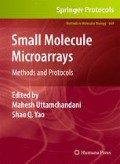Abstract
Today, lithographic methods enable combinatorial synthesis of >50,000 oligonucleotides per cm2, an advance that has revolutionized the whole field of genomics. A similar development is expected for the field of proteomics, provided that affordable, very high-density peptide arrays are available. However, peptide arrays lag behind oligonucleotide arrays. This is mainly due to the monomer-by-monomer repeated consecutive coupling of 20 different amino acids associated with lithography, which adds up to an excessive number of coupling cycles. A combinatorial synthesis based on electrically charged solid amino acid particles resolves this problem. A computer chip consecutively addresses the different charged particles to a solid support, where, when completed, the whole layer of solid amino acid particles is melted at once. This frees hitherto immobilized amino acids to couple all 20 different amino acids in one single coupling reaction to the support. The method should allow for the translation of entire genomes into a set of overlapping peptides to be used in proteome research.
Access this chapter
Tax calculation will be finalised at checkout
Purchases are for personal use only
References
Merrifield, R. B. (1963) Solid phase peptide synthesis. I. The synthesis of a tetrapeptide. Journal of the American Chemical Society 85, 2149–54.
Frank, R. (1992) Spot synthesis: an easy technique for the positionally addressable, parallel chemical synthesis on a membrane support. Tetrahedron 48, 9217–32.
Frank, R. (2002) The SPOT synthesis technique – synthetic peptide arrays on membrane supports – principles and applications. Journal of Immunological Methods 267, 13–26.
Hilpert, K., Winkler, D. F. H., and Hancock, R. E. W. (2007) Peptide arrays on cellulose support: SPOT synthesis, a time and cost efficient method for synthesis of large numbers of peptides in a parallel and addressable fashion. Nature Protocols 2, 1333–49.
Frank, R. (2002) High density peptide microarrays: emerging tools for functional genomics and proteomics. Combinatorial Chemistry & High Throughput Screening 5, 429–40.
Eichler, J. (2005) Synthetic peptide arrays and peptide combinatorial libraries for the exploration of protein–ligand interactions and the design of protein inhibitors. Combinatorial Chemistry & High Throughput Screening 8, 135–43.
Min, D-H., and Mrksich, M. (2004) Peptide arrays: towards routine implementation. Current Opinion in Chemical Biology 8, 554–8.
Fodor, S. P. A., Read, J. L., Pirrung, M. C., Stryer, L., Lu, A. T., and Solas, D. (1991) Light-directed, spatially addressable parallel chemical synthesis. Science 251, 767–73.
Pellois, J. P., Zhou, X., Srivannavit, O., Zhou, T., Gulari, E., and Gao, X. (2002) Individually addressable parallel peptide synthesis on a microchip. Nature Biotechnology 20, 922–6.
Stadler, V., Felgenhauer, T., Beyer, M., Fernandez, S., Leibe, K., Güttler, S., Gröning, M., König, K., Torralba, G., Hausmann, M., Lindenstruth, V., Nesterov, A., Block, I., Pipkorn, R., Poustka, A., Bischoff, F. R., and Breitling, F. (2008) Combinatorial synthesis of peptide arrays with a laser printer. Angewandte Chemie (International ed. in English) 47, 7132–35.
Beyer, M., Nesterov, A., Block, I., König, K., Felgenhauer, T., Fernandez, S., Leibe, K., Torralba, G., Hausmann, M., Trunk, U., Lindenstruth, V., Bischoff, F. R., Stadler, V., and Breitling, F. (2007) Combinatorial synthesis of peptide arrays onto a microchip. Science 318, 1888.
Fmoc solid phase peptide synthesis – A practical approach (Eds.: W. C. Chan, P. D. White), Oxford University Press, Oxford, 2000, pp. 41–76.
Kawagishi, Y., Ishida, Y., and Ishikawa, K. (1981) Metal complexes for use in developers for electrostatic images, charge control function. US patent application 4404271A1.
Stadler, V., Beyer, M., König, K., Nesterov, A., Torralba, G., Lindenstruth, V., Hausmann, M., Bischoff, F. R., and Breitling, F. (2007) Multifunctional CMOS microchip coatings for protein and peptide arrays. Journal of Proteome Research 6, 3197–202.
Beyer, M., Felgenhauer, T., Bischoff, F. R., Breitling, F., and Stadler, V. (2006) A novel glass-slide based peptide array support with high functionality resisting non-specific protein adsorption. Biomaterials 27, 3505–14.
Stadler, V., Kirmse, R., Beyer, M., Breitling, F., Ludwig, T. and Bischoff, F. R. (2008) PEGMA/MMA copolymer graftings: Generation, protein resistance, and a hydrophobic domain. Langmuir 24, 8151–57.
Acknowledgments
This chapter is dedicated to the memory of Prof. Annemarie Poustka.
Author information
Authors and Affiliations
Editor information
Editors and Affiliations
Rights and permissions
Copyright information
© 2010 Springer Science+Business Media, LLC
About this protocol
Cite this protocol
Nesterov, A. et al. (2010). Peptide Arrays with a Chip. In: Uttamchandani, M., Yao, S. (eds) Small Molecule Microarrays. Methods in Molecular Biology, vol 669. Humana Press, Totowa, NJ. https://doi.org/10.1007/978-1-60761-845-4_9
Download citation
DOI: https://doi.org/10.1007/978-1-60761-845-4_9
Published:
Publisher Name: Humana Press, Totowa, NJ
Print ISBN: 978-1-60761-844-7
Online ISBN: 978-1-60761-845-4
eBook Packages: Springer Protocols

